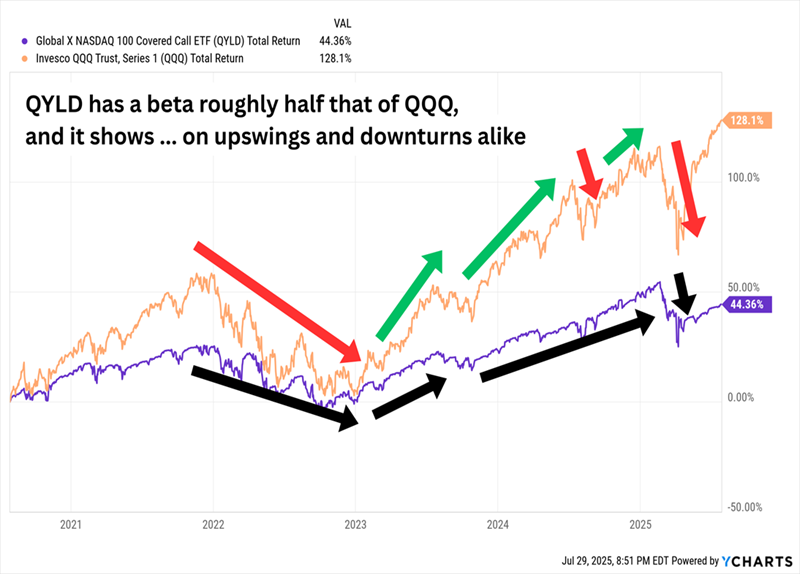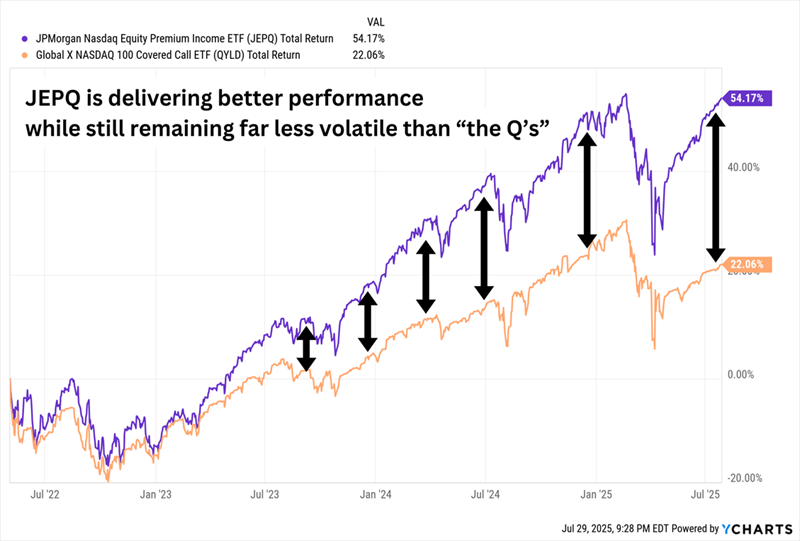The Nasdaq has been rallying nonstop since April. Let’s discuss three payouts up to 11.2% that play the rally.
The catalyst is the “rise of the machines” with companies replacing expensive humans with cheaper robots and AI tools. Hiring numbers are down and (paradoxically to some) the Nasdaq continues to levitate higher.
This summer heater in tech stocks is no surprise to us contrarians. The Naz tech giants are enjoying expanding profit margins! Amazon (AMZN) CEO Andy Jassy recently admitted the company’s workforce will shrink, replaced by AI. This is bad for those who work at Amazon, but great for those who own AMZN.
Microsoft (MSFT) also announced big layoffs in recent months, especially in sales and support roles easily handled by AI-driven tools. And my friends at Alphabet (GOOG) are looking over their shoulders wondering how much longer their services will be needed.
This is a dicey time to be a rank-and-file tech bro—but an exciting time to be a tech savvy dividend investor. Here are three “one-click” (or one-tap) dividend plays on this megatrend!
Global X Nasdaq 100 Covered Call ETF (QYLD)
Dividend Yield: 11.2%
Alphabet (GOOG) will never pay 11.2%. But we can buy GOOG and the rest of Big Tech for 11.2% payouts via a fund like Global X Nasdaq 100 Covered Call ETF (QYLD), which sells (“writes”) covered call funds on the Naz index itself to generate additional income.
QYLD buys the stocks in the Nasdaq-100 and simultaneously writes covered calls on the index itself to generate income—which it pays out monthly.
It’s not perfect exposure to technology. The Nasdaq-100 is made up of the 100 largest nonfinancial companies listed on the Nasdaq exchange, and in fact, it includes stocks from 10 different sectors. However, it’s still tech-heavy, at 60% of the index’s weight, and includes trillion-dollar tech firms like Apple (AAPL) and Microsoft (MSFT), so it’s generally treated as a proxy for the sector.
But that’s a marginal consideration. The real tradeoff to weigh is tactical. By selling covered calls against the Nasdaq, we’re sacrificing potential upside in return for a.) much more stability and b.) the very high income from the options premiums it collects.
QYLD will rarely outperform the “QQQs” to the upside. But it also has less downside exposure, thanks to the constant income it generates by selling the call options.
QYLD: Wilder Rips, But Deeper Dips

JPMorgan Nasdaq Equity Premium Income (JEPQ)
Dividend Yield: 10.8%
The JPMorgan Nasdaq Equity Premium Income (JEPQ) uses a similar strategy, owning roughly 100 or so Nasdaq stocks while selling calls against the Nasdaq-100. It also doles out its massive dividend in monthly distributions.
But it’s a little more flexible because of a big difference between it and QYLD: management. Whereas QYLD tracks an index and typically has only one options position at any given moment, JEPQ is led by 38-year veteran Hamilton Reiner and a team of four co-managers who can sell multiple contracts.
I’ve also pointed out in the past that while both funds hold pretty much the same stocks, JEPQ is more heavily weighted in mega-cap names than QYLD. But that’s not by definition. Indeed, today, JEPQ has a smaller percentage of assets invested in each of its top 10 holdings than QYLD.
These might not seem like meaningful differences, but over time we see that JPMorgan’s “homemade” strategy beat QYLD’s straightforward approach.
JEPQ Has More Than Doubled Up QYLD Since Inception

Active management can make a world of difference—so much so that I typically prefer closed-end funds (CEFs) over comparable ETFs. Let’s walk over to the CEF side of the border to review our final call writer.
Columbia Seligman Premium Technology Growth Fund (STK)
Distribution Rate: 6.0%
Columbia Seligman Premium Technology Growth Fund (STK) is a CEF, while QYLD and JEPQ are ETFs. But the differences go far beyond fund type.
Paul Wick, who has nearly four decades of experience, and a team of five other managers run a slimmer portfolio of about 55 holdings. The portfolio is also a purer—though not pure—play on technology, with about 70% of assets dedicated to the sector. STK also is interested in “growth at a reasonable price” (GARP); a relatively more value-priced portfolio shows it, with price-to-earnings, sales, book, and cash flow all lower than the other ETFs.
And whereas QYLD tries to own Nasdaq-100 stocks (and while JEPQ has a broader mandate but looks index-esque in its larger holdings), STK is much more willing to take some shots—stocks such as Lam Research (LRCX) and industrial Bloom Energy (BE) punch well above their weight.
Columbia Seligman’s CEF writes covered calls, too—typically on the Nasdaq-100, but again, it has more flexibility. For instance, right now, management is selling Apple calls, too.
The strategy works. In fact, it works mighty well.
In Fact, STK Often Outperforms the QQQ!

STK still has its drawbacks. Unlike other covered-call funds, Columbia Seligman’s fund is actually more volatile than the Nasdaq, not less. Moreover, while the ETFs pay monthly, this CEF is only paying us on a quarterly schedule—and at current prices (which admittedly represent a slight discount to net asset value), it’s paying us just half as much as JEPQ and QYLD.
If you prefer monthly dividends, well, I don’t blame you. I like getting paid more often too!
In addition to the ideas we discussed here, there are plenty of payers beyond “Tech Bro Land” yielding 8%+ that are attractive buys today—click here for my favorites.
Before you make your next trade, you'll want to hear this.
MarketBeat keeps track of Wall Street's top-rated and best performing research analysts and the stocks they recommend to their clients on a daily basis.
Our team has identified the five stocks that top analysts are quietly whispering to their clients to buy now before the broader market catches on... and none of the big name stocks were on the list.
They believe these five stocks are the five best companies for investors to buy now...
See The Five Stocks Here
Learn the basics of options trading and how to use them to boost returns and manage risk with this free report from MarketBeat. Click the link below to get your free copy.
Get This Free Report